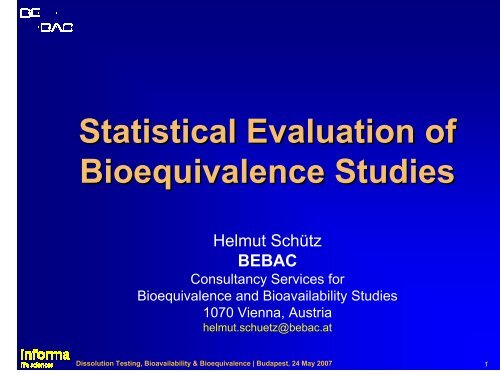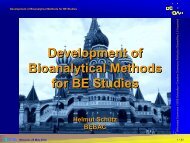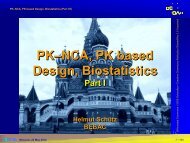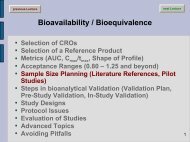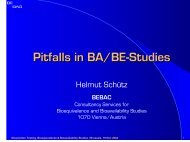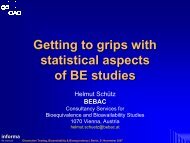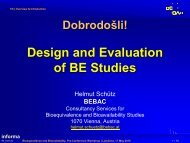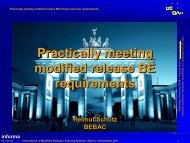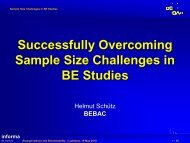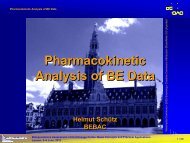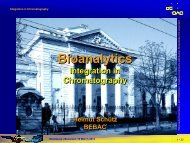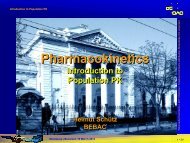Statistical Evaluation of Bioequivalence Studies - BEBAC ...
Statistical Evaluation of Bioequivalence Studies - BEBAC ...
Statistical Evaluation of Bioequivalence Studies - BEBAC ...
- No tags were found...
Create successful ePaper yourself
Turn your PDF publications into a flip-book with our unique Google optimized e-Paper software.
<strong>Statistical</strong> <strong>Evaluation</strong> <strong>of</strong><strong>Bioequivalence</strong> <strong>Studies</strong>Helmut Schütz<strong>BEBAC</strong>Consultancy Services for<strong>Bioequivalence</strong> and Bioavailability <strong>Studies</strong>1070 Vienna, Austriahelmut.schuetz@bebac.atDissolution Testing, Bioavailability & <strong>Bioequivalence</strong> | Budapest, 24 May 2007 1
Assumptions: StatisticsDistribution• IDD (Independent Identically Distribution)1.4TestReference1.21.00.80.60.40.20.00.0 0.5 1.0 1.5 2.0 2.5 3.0Dissolution Testing, Bioavailability & <strong>Bioequivalence</strong> | Budapest, 24 May 2007 4
Assumptions: StatisticsMultiplicative Model (without carryover)X = µ ⋅π ⋅Φ⋅s ⋅eijk k l ik ijks ik : random subject effect, e ijk : random errorMain Assumptions:• All ln{s ik } and ln{e ijk } are independentlyand normally distributed about unity withvariances σ² s and σ² e .• All observations made on different subjectsare independent.Dissolution Testing, Bioavailability & <strong>Bioequivalence</strong> | Budapest, 24 May 2007 7
Nonparametrics5. In which cases may a non-parametric statistical modelbe used?The NfG states under 3.6.1–<strong>Statistical</strong> analysis: “AUC and C maxshould be analysed using ANOVA after log transformation.”The reasons for this request are the following:a) the AUC and C maxvalues as biological parameters are usually notnormally distributed;b) a multiplicative model may be plausible;c) after log transformation the distribution may allow a parametricanalysis.Comments:a) – true b) – true c) – maybe, but may also terribly failAnonymous [EMEA/CHMP/EWP/40326/2006];Questions & Answers on the BA and BE Guideline (27 July 2006)Dissolution Testing, Bioavailability & <strong>Bioequivalence</strong> | Budapest, 24 May 2007 11
Nonparametrics5. In which cases may a non-parametric statistical modelbe used?However, the true distribution in a pharmacokinetic data set usuallycannot be characterised due to the small sample size, so it is notrecommended to have the analysis strategy depend on a pre-testfor normality. Parametric testing using ANOVA on log-transformeddata should be the rule. Results from non-parametric statisticalmethods or other statistical approaches are nevertheless welcomeas sensitivity analyses. Such analyses can provide reassurancethat conclusions from the experiment are robust against violations<strong>of</strong> the assumptions underlying the analysis strategy.Comment: It is well known that the efficiency <strong>of</strong> e.g., the Wilcoxon-Mann-Whitney test for normal distributed data is 3/π ≈95.5 %; fornot normal distributed data the efficiency is > 100 %!Dissolution Testing, Bioavailability & <strong>Bioequivalence</strong> | Budapest, 24 May 2007 12
Acceptance range for C max• Wider acceptance range for C max(e.g., 0.75–1.33), if• justified based on safety and efficacy grounds, and• specified in the study protocol EU, WHO, Australia, NZ, Turkey, Saudia Arabia,Malaysia, Taiwan, ASEAN States, Argentina RSA Standard for all drugs (no justification) Japan, Switzerland (even for AUC)– FDA, Brazil, IndiaDissolution Testing, Bioavailability & <strong>Bioequivalence</strong> | Budapest, 24 May 2007 15
Acceptance range for C max2. Assessment <strong>of</strong> C max in bioequivalence studies. In whichcases is it allowed to use a wider acceptance range for theratio <strong>of</strong> C max ?The NfG states under 3.6.2 that “With respect to the ratio <strong>of</strong> C maxthe 90% confidence interval for this measure <strong>of</strong> relative bioavailabilityshould lie within an acceptance range <strong>of</strong> 0.80 – 1.25. In specificcases, such as a narrow therapeutic range, the acceptanceinterval may need to be tightened.”The NfG also states that “In certain cases a wider interval may beacceptable. The interval must be prospectively defined, e.g. 0.75 –1.33, and justified addressing in particular any safety or efficacyconcerns for patients switched between formulations”.Anonymous [EMEA/CHMP/EWP/40326/2006];Questions & Answers on the BA and BE Guideline (27 July 2006)Dissolution Testing, Bioavailability & <strong>Bioequivalence</strong> | Budapest, 24 May 2007 16
Acceptance range for C maxThe possibility <strong>of</strong>fered here by the guideline to widen the acceptancerange <strong>of</strong> 0.80 – 1.25 for the ratio <strong>of</strong> C max (not for AUC) shouldbe considered exceptional and limited to a small widening (0.75 −1.33).Restricted to products for which at least one <strong>of</strong> the following criteriaapplies:1) Data on PK/PD relationships (safety and efficacy) adequate todemonstrate that PD is not affected in a clinically significant way.2) If PK/PD data are inconclusive or not available, clinical safety andefficacy data may be used, but specific for the compound andpersuasive.3) Reference product is a HVDP. See #8 <strong>of</strong> the Q&A document.Comment: In a silent side-step widening <strong>of</strong> the acceptance rangefor AUC (NfG: „AUC-ratio: […] In rare cases a wider acceptancerange may be acceptable if it is based on sound clinical justification.“)was entirely eliminated.Dissolution Testing, Bioavailability & <strong>Bioequivalence</strong> | Budapest, 24 May 2007 17
Outliers• Problems• Parametric methods (ANOVA, GLM) arevery sensitive to outliers• A single outlier may underpower a properly sizedstudy.• Exclusion <strong>of</strong> outliers only possible if procedurestated in the protocol, and reason is justfied, e.g.,‣ Lacking compliance (subject did not take the medication),‣ Vomiting (up to 2 × t maxfor IR, at all times for MR),‣ Analytical problems (e.g., interferences in chromatography);‣ Not acceptable if only based on statistical grounds.Dissolution Testing, Bioavailability & <strong>Bioequivalence</strong> | Budapest, 24 May 2007 18
Outliers• Solution I• Since assumptions are violated, you mayapply a statistical method which does not relyon those!• Drawback: Regulatory acceptance?Dissolution Testing, Bioavailability & <strong>Bioequivalence</strong> | Budapest, 24 May 2007 19
Outliers• Solution II• Stay with the parametric method, but• evaluation <strong>of</strong> both the full (original) data set, and thereduced data set (outliers exluded), and• discuss influence on the outcome <strong>of</strong> the study.• In accordance with EMEA’s Q&A #3:• Exceptional reasons may justify post-hoc data exclusionbut this should be considered with utmost care. In such acase, the applicant must demonstrate that the conditionstated to cause the deviation is present in the outlier(s)only and absence <strong>of</strong> this condition has been investigatedusing the same criteria for all other subjects.• Results <strong>of</strong> statistical analyses with and without the group<strong>of</strong> excluded subjects should be provided.Dissolution Testing, Bioavailability & <strong>Bioequivalence</strong> | Budapest, 24 May 2007 20
Re-testing <strong>of</strong> subjects• If you suspect a product failure <strong>of</strong> thereference formulation, you may considerre-testing;• the outlying subject should be re-tested• with both the test and reference.• Include ≥5 subjects, who showed a ‘normal’ responsein the main study (i.e., size <strong>of</strong> re-testedgroup ≥6 or 20 % <strong>of</strong> subjects, whichever islarger).• Expect questions anyway (although sometimessuggested by the FDA, not covered in any guideline;statistical evaluation not trivial…)Dissolution Testing, Bioavailability & <strong>Bioequivalence</strong> | Budapest, 24 May 2007 21
Re-testing <strong>of</strong> subjectsn=24: 83.3%–131.1% ⇒ +n=6: 86.7%–122.5%2500Re-test20001500100050000.5 1.5 2.5 3.5 4.5periodDissolution Testing, Bioavailability & <strong>Bioequivalence</strong> | Budapest, 24 May 2007 22
NTI Drugs• USA, Japan No difference to other drugs• WHO, EU, 90 % CI, acceptance range may beNZ, India tightened• Denmark 90 % CI within 0.90–1.11 for somedrugs http://www.dkma.dk/1024/visUKLSArtikel.asp?artikelID=6437 (17 Jan 2006)• Brazil 95 % CI within 0.80–1.25• Canada Common procedure; consideringAUC: 90 % CI within 0.90–1.12C max: 90 % CI within 0.80–1.25http://www.hc-sc.gc.ca/dhp-mps/alt_formats/hpfb-gpsa/pdf/prodpharma/crit_dose_e.pdf (5 Jul 2005)Dissolution Testing, Bioavailability & <strong>Bioequivalence</strong> | Budapest, 24 May 2007 23
Add-on Design• Reasonable,• if uncertain sample size estimate,• for ethical reasons. Canada If BE not shown, additional subjects are included;F-test (equality <strong>of</strong> variances), pooledanalysis. No α-adjustment. Japan 2 nd part with sample size ≥ 1 st part / 2 RSA max. sample size must be stated a-priori NZ Group sequential design (with α-adjustment)– USA No way± EU <strong>Evaluation</strong> <strong>of</strong> first part by an independentstatistician (CV only!). Not covered in NfG.Dissolution Testing, Bioavailability & <strong>Bioequivalence</strong> | Budapest, 24 May 2007 24
Group Sequential Design• Not mentioned in any Guideline, but• are standard in clincial research.• Although discussed at BioInternationals ’89to ’96, no concensus was reached.± EU• Personal Experience:‣ A proposed method *) was not accepted in theplanning phase (3 cases Germany).*)L.A. Gould;Group Sequential Extension <strong>of</strong> a Standard <strong>Bioequivalence</strong> TestingProcedure.J. Pharmacokin. Biopharm. 32(1), 57-86 (1995)Dissolution Testing, Bioavailability & <strong>Bioequivalence</strong> | Budapest, 24 May 2007 25
Group Sequential Design± EU• Personal Experience:‣ <strong>Evaluation</strong> <strong>of</strong> first part by an independent statistician(CV only!), performance <strong>of</strong> a second part, evaluation<strong>of</strong> pooled data without α-adjustment – 90 % CI(2 cases Germany, 1 case France).‣ May be a reasonable approach, because Add onDesigns are in practice in Canada (since 1991), andJapan (since at least 1997).Dissolution Testing, Bioavailability & <strong>Bioequivalence</strong> | Budapest, 24 May 2007 26
HVDs/HVDPs• Highly Variable Drugs / Drug Products(intra-subject variability >30 %) USA Replicate Design recommended.± EU […] under certain circumstances […] alternativewell-established designs could be consideredsuch as […] replicate designs for substanceswith highly variable disposition.± NZ […] studies in which treatments are replicatedwithin each subject, may improve discriminatorypower for highly variable medicines.? Reference Scaled Average <strong>Bioequivalence</strong> (only statedin South African Guidelines).Dissolution Testing, Bioavailability & <strong>Bioequivalence</strong> | Budapest, 24 May 2007 27
<strong>Studies</strong><strong>of</strong> >2 formulations• Disadvantages• Not mentioned in any guideline – exceptBrazil’s ANVISA.• <strong>Statistical</strong> analysis more complicated –especially in the case <strong>of</strong> drop outs.• May need measures against multiplicity,increasing the sample size.Dissolution Testing, Bioavailability & <strong>Bioequivalence</strong> | Budapest, 24 May 2007 29
<strong>Studies</strong><strong>of</strong> >2 formulations• Bonferroni-correction needed if more than1 formulation will be marketed (for 3 simultaneouscomparisons without correctionpatient’s risk increases from 5% to 14%).kP α=0.05P α=0.10α adj.P αadj.α adj.P αadj.15.00%10.00%0.05005.00%0.10010.00%29.75%19.00%0.02504.94%0.0509.75%314.26%27.10%0.01674.92%0.0336.67%418.55%34.39%0.01254.91%0.0259.63%522.62%40.95%0.01004.90%0.0209.61%626.49%46.86%0.00834.90%0.0179.59%Dissolution Testing, Bioavailability & <strong>Bioequivalence</strong> | Budapest, 24 May 2007 30
<strong>Studies</strong><strong>of</strong> >2 formulations• Often a wrong design is applied, namely• a repeated latin square, instead <strong>of</strong>• a Williams’ design.• Example for 3 treatments (T 1 , T 2 , R)3 sequence latin square 6 sequence Williams’ designSeq.P 1P 2P 3Seq.P 1P 2P 31T 1T 2R1T 1T 2R2T 2RT 12T 2RT 13RT 1T 23RT 1T 24T 1RT 25T 2T 1R6RT 2T 1Dissolution Testing, Bioavailability & <strong>Bioequivalence</strong> | Budapest, 24 May 2007 31
Parallel Groups• Sometimes it is infeasible or even impossibleto demonstrate BE from a ‘conventionally’designed cross-over study; a study in parallelgroups should be employed:• Drugs with long half lives.• Potentially toxic drugs.• <strong>Studies</strong> in patients, where the condition <strong>of</strong> thedisease irreversibly changes.Dissolution Testing, Bioavailability & <strong>Bioequivalence</strong> | Budapest, 24 May 2007 32
Parallel Groups• Design Issues• EMEA NfG on BA/BE• 3.2.4 Genetic phenotypingPhenotyping and/or genotyping <strong>of</strong> subjects should beconsidered for […] all studies using parallel group design.If a drug is known to be subject to major genetic polymorphism,studies could be performed in panels <strong>of</strong> subjects <strong>of</strong> knownphenotype or genotype for the polymorphism in question.• Since the comparison is based on inter-subject effects,• stratify groups for phenotype/genotype.• run two studies <strong>of</strong> the respective phenotype/genotype (?)• one study <strong>of</strong> the major phenotype/genotype (?)Dissolution Testing, Bioavailability & <strong>Bioequivalence</strong> | Budapest, 24 May 2007 33
Sample data set• Will be used throughout the lecture• 2×2 Cross-over Study• 24 subjects (balanced: TR=RT=12)• Single dose• Target parameter: AUC 0-t• CV intra 20.0 %• CV inter 32.6 %• http://bebac.at/downloads/24sub.txt(CSV-format)Trt111222111222111222111222RandRTRTRTTRTRTRRTRTRTTRTRTRRTRTRTTRTRTRRTRTRTTRTRTRSub123456789101112131415161718192021222324P144.133.645.519.567.225.735.326.038.233.625.144.125.658.047.216.547.322.617.551.724.536.329.418.3P239.123.840.821.151.530.126.736.557.832.536.842.920.145.351.821.439.417.330.136.018.227.239.620.7Dissolution Testing, Bioavailability & <strong>Bioequivalence</strong> | Budapest, 24 May 2007 35
Parallel Groups: Example• <strong>Evaluation</strong> (sample data set, period 1 only)• Original data set• Balanced (T 12, R 12)• Equal variances (s² R0.1292, s² T0.1796)F-ratio test p 0.5947Levene test p 0.5867• Modified data set:• Values <strong>of</strong> subjects 4 – 6 × 3• Subjects 22 – 24 removed• Inbalanced (T 9, R 12)• Unequal variances (s² R0.1292, s² T0.5639)F-ratio test p 0.0272Levene test p 0.1070Dissolution Testing, Bioavailability & <strong>Bioequivalence</strong> | Budapest, 24 May 2007 36
Parallel Groups: Example• <strong>Evaluation</strong> (original data set)• Is your s<strong>of</strong>tware able to give the correct answer?Program / Method‘manual’ (Excel 2000)R 2.5.0 (2007)NCSS 2001 (2001)STATISTICA 5.1H (1997)WinNonlin 5.2 (2007)Kinetica 4.4.1 (2007)EquivTest/PK (2006)equal variances63.51% – 110.19%63.51% – 110.19%63.51% – 110.19%63.51% – 110.19%63.51% – 110.20%63.51% – 110.19%63.51% – 110.18%unequal variances63.48% – 110.25%63.49% – 110.22%63.49% – 110.22%63.49% – 110.22%not implemented!not implemented!not implemented!Dissolution Testing, Bioavailability & <strong>Bioequivalence</strong> | Budapest, 24 May 2007 37
Parallel Groups: Example• <strong>Evaluation</strong> (modified data set)ProgramR 2.5.0 (2007)NCSS 2001 (2001)equal variances81.21% – 190.41%81.21% – 190.41%unequal variances76.36% – 202.51%76.36% – 202.51%• Inflated α-risk in ‘conventional’ t-test (naive pooling) isreflected in a tighter confidence interval.• Preliminary testing for equality in variances is flawed* ) andshould be avoided (FDA).• Approximations (e.g., Satterthwaite, Aspin-Welch, Howe,Milliken-Johnson) are currently not implemented in packages‘specialized’ in BE (WinNonlin, Kinetica, EquivTest/PK)!*) Moser, B.K. and Stevens, G.R.;Homogeneity <strong>of</strong> variance in the two-sample means test.Amer. Statist. 46, 19-21 (1992)Dissolution Testing, Bioavailability & <strong>Bioequivalence</strong> | Budapest, 24 May 2007 38
Side noteValidated?Sure!But what if2 × 2 = 5 ?Dissolution Testing, Bioavailability & <strong>Bioequivalence</strong> | Budapest, 24 May 2007 39
Sample Size• Minimum Number <strong>of</strong> Subjects• 12 – WHO, EU, CAN, NZ, AUS, Malaysia, Argentina,ASEAN States, South Africa (20 for MR).• 12 (?) – USA: The total number <strong>of</strong> subjects in thestudy should provide adequate power for BE demonstration[…]. For modified-release products, a pilotstudy can help determine the sampling schedule toassess lag time and dose dumping. A pilot study thatdocuments BE may be appropriate, provided its designand exe-cution are suitable and a sufficient number <strong>of</strong>subjects (e.g., 12) have completed the study.• 24 – Saudia Arabia (12 – 24 if statistically justifiable).• 24 – Brazil.Dissolution Testing, Bioavailability & <strong>Bioequivalence</strong> | Budapest, 24 May 2007 40
Sample Size• Maximum Number <strong>of</strong> Subjects• New Zealand:If the calculated number <strong>of</strong> subjects appears to be higherthan is ethically justifiable, it may be necessary to accept astatistical power which is less than desirable. Normally it isnot practical to use more than about 40 subjects in abioavailability study.• All others:Not specified in BE-Guidelines (judged by IEC/IRB or localAuthorities?); ICH E9 (Section 3.5) applies:The number <strong>of</strong> subjects in a clinical trial should always belarge enough to provide a reliable answer to the questionsaddressed.Dissolution Testing, Bioavailability & <strong>Bioequivalence</strong> | Budapest, 24 May 2007 41
Sample Size: Planning• NfG on the Investigation <strong>of</strong> BA/BE• The number <strong>of</strong> subjects required is determined by• the error variance associated with the primary characteristicto be studied as estimated from‣ a pilot experiment,‣ previous studies, or‣ published data,• the significance level desired,• the expected deviation (∆) from the reference productcompatible with BE and,• the required power.Dissolution Testing, Bioavailability & <strong>Bioequivalence</strong> | Budapest, 24 May 2007 42
Sample Size: Planning• NfG on the Investigation <strong>of</strong> BA/BE• Problems/solutions• … the error variance associated with the primarycharacteristic to be studied …‣ Since BE must be shown both for AUC and C max, and,‣ if you plan your sample size only for the ‘primary characteristic’(e.g., AUC), in many cases you will fail for thesecondary parameter (e.g., C max), which most likely showshigher variability – your study will be underpowered.‣ Based on the assumption, that CV is identical for test andreference (what if only the reference formulation has highvariability, e.g., *prazoles?).Dissolution Testing, Bioavailability & <strong>Bioequivalence</strong> | Budapest, 24 May 2007 43
Sample Size: Planning• NfG on the Investigation <strong>of</strong> BA/BE• Problems/solutions• … as estimated from‣ a pilot experiment,‣ previous studies, or‣ published data,• The correct order should read:1. previous studies ⇒ 2. pilot study ⇒ 3. published data.‣ Only in the first case you ‘know’ all constraints resulting invariability.‣ Pilot studies are <strong>of</strong>ten too small to get reliable estimates <strong>of</strong>variability.‣ Advisable only if you have data from a couple <strong>of</strong> studies.Dissolution Testing, Bioavailability & <strong>Bioequivalence</strong> | Budapest, 24 May 2007 44
Sample Size: Planning• NfG on the Investigation <strong>of</strong> BA/BE• Problems/solutions• … the significance level desired …‣ Throughout the NfG the significance level (α, error type I:patient’s risk to be treated with a bioinequivalent drug) isfixed to 5 % (corresponding to a 90 % confidence interval).‣ You may desire a higher significance level, but such aprocedure is not considered acceptable.‣ In special cases (e.g., dose proportionality testing), acorrection for multiplicity may be necessary.‣ In some restrictive legislations (e.g., Brazil’s ANVISA),α must be tightened to 2.5 % for NTIDs (95 % confidenceinterval).Dissolution Testing, Bioavailability & <strong>Bioequivalence</strong> | Budapest, 24 May 2007 45
Sample Size: Planning• NfG on the Investigation <strong>of</strong> BA/BE• Problems/solutions• … the expected deviation (∆) from the reference …‣ Reliable estimate only from a previous full-sized study.‣ If you are using data from a pilot study, allow for a safetymargin.‣ If no data are available, commonly a GMR (geometrictest/reference-ratio) <strong>of</strong> 0.95 (∆ = 5 %) is used.‣ If more than ∆ = 10 % is expected, questions from theethics committee are likely.Dissolution Testing, Bioavailability & <strong>Bioequivalence</strong> | Budapest, 24 May 2007 46
Sample Size: Planning• NfG on the Investigation <strong>of</strong> BA/BE• Problems/solutions• … the required power.‣ Generally the power is set to at least 80 % (β, error type II:producers’s risk to get no approval for a bioequivalentdrug; power = 1 – β).Remember: 1 out <strong>of</strong> 5 studies will fail just by chance!‣ If you plan for power <strong>of</strong> less than 70 %, problems with theethics committee are likely.‣ If you plan for power <strong>of</strong> more than 90 % (especially withlow variability drugs), problems with the regulator arepossible (‘forced bioequivalence’).‣ Add subjects according to the expected drop-out rate!Dissolution Testing, Bioavailability & <strong>Bioequivalence</strong> | Budapest, 24 May 2007 47
Sample Size: PlanningDoxicycline (37 studies ref. by Blume/Mutschler 1996)12108frequency642total0101520CVs2530200 mg100 mgstudiesDissolution Testing, Bioavailability & <strong>Bioequivalence</strong> | Budapest, 24 May 2007 48
Sample Size: PowerPower to show BEwith 12 – 32 subjectsfor CV intra =20%Power10.90.80.70.62×2 Cross-Over322824222018160.514120.4CV = 20 %0.30.20.8 0.85 0.9 0.95 1 1.05 1.1 1.15 1.2 1.25µT/µRDissolution Testing, Bioavailability & <strong>Bioequivalence</strong> | Budapest, 24 May 2007 49
Sample Size: PowerPower to show BEwith 12 – 32 subjectsfor CV intra =20%10.90.80.72×2 Cross-Over10.950.92×2 Cross-Over11.051.1Power0.60.51.150.40.30.850.212 16 20 24 28 3212 16 20 24 28 32Number <strong>of</strong> subjectsNumber <strong>of</strong> subjectsCV = 20 %CV = 20 %Dissolution Testing, Bioavailability & <strong>Bioequivalence</strong> | Budapest, 24 May 2007 50
Sample Size: PowerEffect <strong>of</strong> drop-outson power to showBE (CV intra 20%,GMR 0.95):• n=24: 0.891• n=20: 0.829 ( -7 %)Power10.90.80.72×2 Cross-Over242220181614• n=16: 0.730 (-12 %)0.6CV = 20 %0.50.85 0.9 0.95 1 1.05 1.1 1.15µT/µRDissolution Testing, Bioavailability & <strong>Bioequivalence</strong> | Budapest, 24 May 2007 51
Sample Size: Sensitivity Analysis• ICH E9• Section 3.5 Sample Size, paragraph 3• The method by which the sample size is calculatedshould be given in the protocol […]. The basis <strong>of</strong> theseestimates should also be given.• It is important to investigate the sensitivity <strong>of</strong> the samplesize estimate to a variety <strong>of</strong> deviations from theseassumptions and this may be facilitated by providing arange <strong>of</strong> sample sizes appropriate for a reasonable range<strong>of</strong> deviations from assumptions.• In confirmatory trials, assumptions should normally bebased on published data or on the results <strong>of</strong> earlier trials.Dissolution Testing, Bioavailability & <strong>Bioequivalence</strong> | Budapest, 24 May 2007 53
Sample Size: Sensitivity Analysis• Observations• Subsets <strong>of</strong> size 12 lead to more consistent results.• If you have stated such a procedure in your protocol, even BEmay be claimed in both subsets, and no further study will benecessary.• If you want to use the upper CL in sample size estimation, youalso get more consistant values.• If you have some previous hints <strong>of</strong> high intra-subject variability(>30%), a pilot study size <strong>of</strong> at least 16 subjects is reasonable.• Conclusions• Small pilot studies (sample size
Low Variability• Drugs / Drug Products with CV intra
Nuisance: period effectTreatment effect, Test versus ReferenceTreatment effect, Test versus ReferenceRatio: Test / Reference AUC0.6 0.8 1 1.2 1.4 1.6 1.8Seq 1Seq 2AllData(1.065)(0.965)(0.875)Period 1Data only(1.102)(0.837)(0.635)Period 2Data only(1.429)(1.114)(0.868)Ratio: Test / Reference AUC0.5 1 1.5 2 2.5Seq 1Seq 2AllData(1.065)(0.965)(0.875)Period 1Data only(1.102)(0.837)(0.635)Period 2Data only(1.429)(1.114)(0.869)Dissolution Testing, Bioavailability & <strong>Bioequivalence</strong> | Budapest, 24 May 2007 62
Nuisance: sequence effect• In a ‘standard’ 2×2 cross-over design• the sequence effect is confounded with• the carryover effect, and• the formulation-by-period interaction.• Therefore, a statistically significant sequenceeffect could indicate that there is• a true sequence effect,• a true carryover effect,• a true formulation by period interaction, or• a failure <strong>of</strong> randomization.Dissolution Testing, Bioavailability & <strong>Bioequivalence</strong> | Budapest, 24 May 2007 63
Nuisance: sequence effect• ‘Two-stage analysis’ 1) was – and still is –<strong>of</strong>ten applied.• Test for a significant sequence effect at α 0.10• If a significant sequence effect is found, evaluation<strong>of</strong> the first period as a parallel design• This procedure was shown to be statisticallyflawed. 2)1) J.E. Grizzle;The two-period change over design and ist use in clinical trials.Biometrics 21, 467-480 (1965)2) P. Freeman;The performance <strong>of</strong> the two-stage analysis <strong>of</strong> two-treatment, two-periodcross-over trials.Statistics in Medicine 8, 1421-1432 (1989)Dissolution Testing, Bioavailability & <strong>Bioequivalence</strong> | Budapest, 24 May 2007 64
Nuisance: sequence effect• In a large metastudy significant sequenceeffects were found at ≈α, both for AUC andC max .* )• 2×2 studies (n=324)• AUC: 34/324 (10.5% ) C max : 37/324 (11.4%)• 6×3 studies (n=96)• AUC: 4/96 (4.2%) C max : 4/96 (4.2%)• For both metrics the distribution <strong>of</strong> p valuesfollowed closely Uniform [0,1]* ) D’Angelo, G., Potvin, D., and J. Turgeon;Carry-over effects in bioequivalence studies.J. Biopharm. Stat. 11, 35-43 (2001)Dissolution Testing, Bioavailability & <strong>Bioequivalence</strong> | Budapest, 24 May 2007 65
Nuisance: sequence effect• These results could beconfirmed (20 publishedstudies, 143 studies from<strong>BEBAC</strong>’s database; AUC):• Significant sequenceeffects in 22/163studies (13.5%)• Significant sequenceeffects in properly plannedstudies should be considereda statistical artefact(significant results areobtained in α <strong>of</strong> studies)p-values for carry-over effects10.80.60.40.20studies with significant p:22/163 (13.5%)0 0.2 0.4 0.6 0.8 1AUC from cross-over studies:Uniform [0,1] quantilesline <strong>of</strong> identityDissolution Testing, Bioavailability & <strong>Bioequivalence</strong> | Budapest, 24 May 2007 66
Nuisance: sequence effect• Conclusions• No valid procedure exists to correct for a truesequence/carry-over effect• A true sequence/carry-over is highly unlikely in aBE study if• the study is performed in healthy subjects,• the drug is not an endogenous entity, and• an adequate washout period (no predose concentrations)was maintained.• Testing for a sequence effect is futile…Dissolution Testing, Bioavailability & <strong>Bioequivalence</strong> | Budapest, 24 May 2007 67
Are we making progress?PubMed/MedLine: (bioequivalence) OR (comparative ANDbioavailability), Field: Title/Abstract, Limits: Humans, Publication Date200Publications on BE referred on PubMed/MedLine150number1005001972197419761978198019821984198619881990year19921994199619982000200220042006Dissolution Testing, Bioavailability & <strong>Bioequivalence</strong> | Budapest, 24 May 2007 68
Are we making progress?• About 3 000 – 10 000 BE studies / year are conductedworldwide; only ∼ 1 – 5% <strong>of</strong> them are published.• Although a standard for publishing data <strong>of</strong> BEstudies was already suggested in 1992, 1)• a review in 2002 found only 17 complete data sets on AUCand 12 on C max . 2)• Since no ‘real world’ data are available, proposed methods(e.g., reference-scaled ABE) rely entirely on simulations!• <strong>Studies</strong> seen by regulators are ‘selection biased’.1) Sauter, R., Steinijans, V.W., Diletti, E., Böhm, E. and H.-U. Schulz;Int. J. Clin. Pharm. Ther. Toxicol. 30/Suppl.1, S7-30 (1992)2) Nakai, K., Fujita, M. and M. Tomita;Int. J. Clin. Pharmacol. Ther. 40, 431-438 (2002)Dissolution Testing, Bioavailability & <strong>Bioequivalence</strong> | Budapest, 24 May 2007 69
Bell curve (and beyond?)• Abraham de Moivre (1667-1754),Pierre-Simon Laplace (1749-1827)Central limit theorem 1733, 1812• Carl F. Gauß (1777-1855)Normal distribution 1795• William S. Gosset, aka Student(1876-1937)t-distribution 1908• Frank Wilcoxon (1892-1965)Nonparametric tests 1945Dissolution Testing, Bioavailability & <strong>Bioequivalence</strong> | Budapest, 24 May 2007 70
...to be rememberedWhenever a theory appears to you asthe only possible one, take this as asign that you have neither understoodthe theory nor the problem which itwas intended to solve.Karl R. PopperEven though it’s applied science we’redealin’ with, it still is – science!Leslie Z. BenetDissolution Testing, Bioavailability & <strong>Bioequivalence</strong> | Budapest, 24 May 2007 71
Conclusions, Outlook• David Bourne’s (Uni. Oklahoma)e-mail list• A rather active list (3200 members,about 50 postings/week) coveringalmost any aspect <strong>of</strong> PK / PD / BA…• Subscriptionhttp://www.boomer.org/pkin/• Search pagehttp://www.boomer.org/pkin/simple.html• BA and BE Forum (<strong>BEBAC</strong> Vienna)• Specialized in dissolution / BA / BE /bioanalytics.• No registration necessary to readpostings.http://forum.bebac.at/• Registration (to post own questions)http://forum.bebac.at/register.phpDissolution Testing, Bioavailability & <strong>Bioequivalence</strong> | Budapest, 24 May 2007 72
<strong>Statistical</strong> <strong>Evaluation</strong> <strong>of</strong><strong>Bioequivalence</strong> <strong>Studies</strong>Thank You!Helmut Schütz<strong>BEBAC</strong>Consultancy Services for<strong>Bioequivalence</strong> and Bioavailability <strong>Studies</strong>1070 Vienna, Austriahelmut.schuetz@bebac.atDissolution Testing, Bioavailability & <strong>Bioequivalence</strong> | Budapest, 24 May 2007 73
Important Documents• EMEA• Biostatistical Methodology in ClinicalTrials (1993)• NfG on the Investigation <strong>of</strong> BA/BE(2001)• Points to Consider on MultiplicityIssues in Clinical Trials (2002)• BA/BE for HVDs/HVDPs: ConceptPaper (2006)• Questions & Answers on the BA andBE Guideline (2006)• ICH• E3: Structure and Content <strong>of</strong> ClinicalStudy Reports (1995)• E6: Good Clinical Practice (1996)• E8: General Considerations forClinical Trials (1997)• E9: <strong>Statistical</strong> Principles for ClinicalTrials (1998)• WHO• Handbook for GCP (2005)• Fortieth Report - TRS No. 937 (2006)• US-FDA• Annex 7: Multisource (generic) pharmaceuticalproducts: guidelines on registrationrequirements to establish interchangeability• Annex 8: Proposal to waive in vivo bioequivalencerequirements for WHO Model List <strong>of</strong>Essential Medicines immediate-release, solidoral dosage forms• Annex 9: Additional guidance for organizationsperforming in vivo bioequivalencestudies• <strong>Statistical</strong> Approaches Establishing <strong>Bioequivalence</strong>(2001)• Bioavailability / <strong>Bioequivalence</strong> – GeneralConsiderations (Revision 1, 2003)• Collection <strong>of</strong> links to global documentshttp://bebac.at/Guidelines.htmDissolution Testing, Bioavailability & <strong>Bioequivalence</strong> | Budapest, 24 May 2007 74


